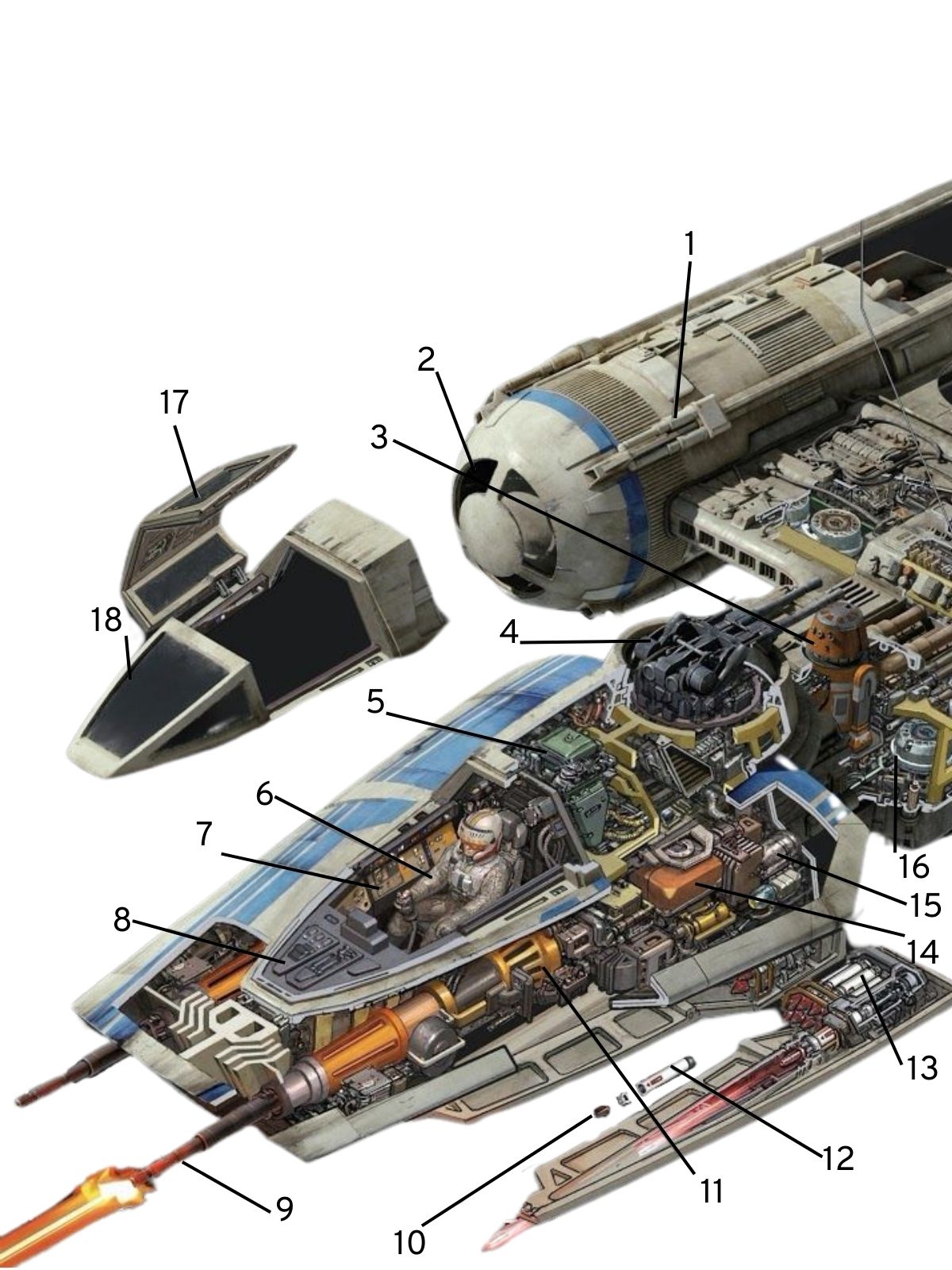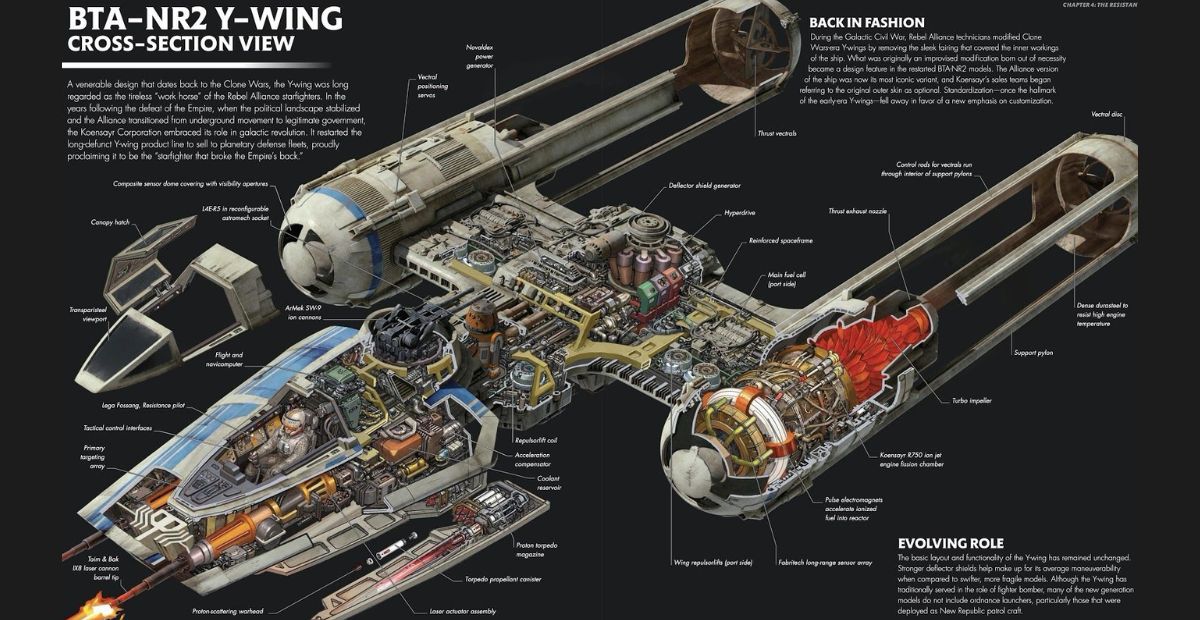In Star Wars lore, the Y-wing has always had a reputation for being slow—something reinforced by its portrayal in various media. Games like Rogue Squadron describe it as sluggish compared to the more agile X-wing and A-wing, and in the movies, it’s often seen as a heavy bomber rather than a nimble starfighter. But is the Y-wing really that slow, or is it just misunderstood?
However, I don’t agree with that. To me, the Y-wing is more than just a slow-moving bomber—it’s a battle-hardened workhorse built for endurance, not speed. It might not zip around like an A-wing, but it can take a hit and still deliver devastating firepower where it counts. That’s why in this article, we’re not just looking at its speed; we’re going deeper into its internal design using cutaway images from Star Wars books to really understand what makes this starfighter special.
Inside the Y-Wing

1. Vectral positioning servos
2. Composite sensor dome covering with visibility apertures
3. L4E-R5 in reconfigurable astromech socket
4. ArMek SW-9 ion cannons
5. Flight and navicomputer
6. Lega Fossang, Resistance pilot
7. Tactical control interfaces
8. Primary targeting array
9. Taim & Bak IX8 laser cannon barrel tip
10. Proton-scattering warhead
11. Laser actuator assembly
12. Torpedo propellant canister
13. Proton torpedo magazine
14. Coolan reservoir
15. Acceleration compensator
16. Repulsorlift coil
17. Canopy hatch
18. Transparisteel viewport

19. Novaldex power generator
20. Thrust vectrals
21. Deflector shield generator
22. Hyperdrive
23. Reinforced spaceframe
24. Main fuel cell (port side)
25. Thrust exhaust nozzle
26. Vectral disc
27. Dense durasteel to resist high engine temperture
28. Support pulon
29. Turbo impeller
30. Keonsayr R750 ion jet engine fission chamber
31. Pulse electromagnets accelerate ionized fuel into reactor
32. Fabritech long-range sensor array
33. Wing repulsorlifts (port side)
And that is everything inside the BTA-NR2 Y-Wing. This is the full details.
We always hear that the Y-wing is slow, but when we actually compare its performance to the X-wing, the difference isn’t as simple as it seems. The BTA-NR2 Y-wing starfighter, also known as the Resistance Y-wing, comes equipped with Koensayr R750 ion jet engines, reaching a maximum atmospheric speed of 1,050 km/h and an acceleration of 2,750 G. In space, it moves at 80 MGLT (Megalight per hour). On paper, that might not sound bad, but when we put it next to the T-65 X-wing, the gap becomes clear.
The X-wing hits the same 1,050 km/h in the atmosphere but boasts a much higher 3,700 G acceleration and a faster sublight speed of 100 MGLT, making it far more maneuverable in a dogfight.
From this comparison, we can clearly see that in the atmosphere, both the X-wing and Y-wing actually have the same top speed. Sure, we can counter that by pointing out that the X-wing is significantly faster in space, but the gap isn’t so extreme that it justifies calling the Y-wing slow. The real difference comes down to their roles—while the X-wing is built for speed and agility, the Y-wing leans into endurance and firepower. The Y-wing wasn’t designed to compete with the X-wing in speed—it was meant to deliver heavy damage and survive the fight.
The Y-Wing Was Designed as a Fighter-Bomber
We always hear the Y-wing being called a bomber, but if we go back to the Original Trilogy, it was never actually labeled as one. So when did that become generally accepted? I think it all started with how the Y-wing was portrayed in A New Hope. It led the Death Star trench run, acting more like a heavy assault craft rather than a dogfighter. Then in Return of the Jedi, while X-wings and A-wings were busy in high-speed dogfights, Y-wings focused on attacking capital ships, reinforcing the idea that they were meant for bombing runs.
So while the Original Trilogy never outright said the Y-wing was a bomber, we can see how its on-screen role, expanded universe material, and official books gradually built that reputation.
However, back in 1987, The Star Wars Sourcebook from the tabletop roleplaying game actually defined the Y-wing as a fighter-bomber. This is where things get interesting. The LucasArts video games that later cemented the Y-wing’s role—like X-Wing and TIE Fighter—took their cues from West End Games’ Star Wars RPG**. In fact, West End didn’t just define the Y-wing; it codified the entire Star Wars universe for decades.
The book even stated: “The Rebel Alliance has lost more of its rugged Y-wing fighter-bombers than any other spacecraft.“

As one fan here put it:
“The LucasArts video games took their cues from West End’s Star Wars tabletop RPG, released in 1987. In fact, West End codified the Star Wars universe for the next 30 years, right up until Disney designated all of that as ‘Legends.”
West End’s influence didn’t stop with video games. Many of the details first laid out in these sourcebooks became the foundation for how the Star Wars universe was built in later films, books, and reference materials—even surviving into the Disney era. As another fan pointed out, these sourcebooks were basically “the Star Wars bible. Or Wookieepedia before Wookieepedia.” They were the go-to reference for writers, game developers, and even filmmakers looking for established lore.

